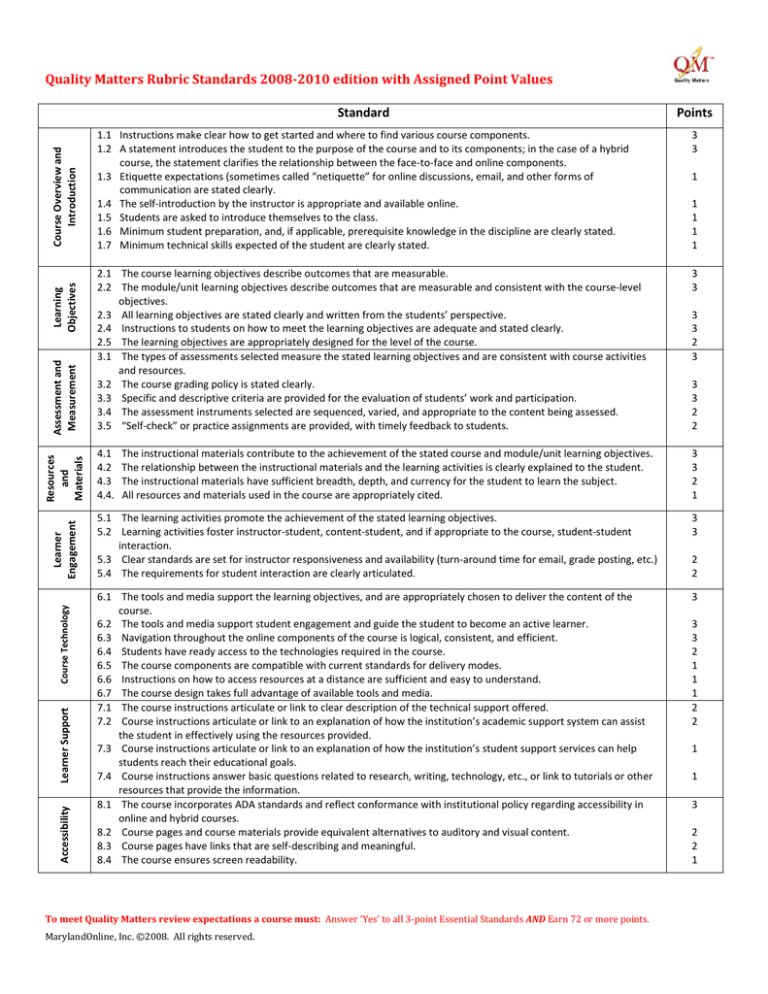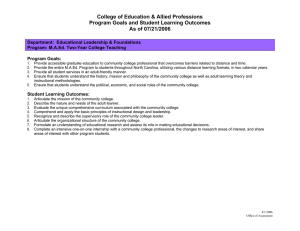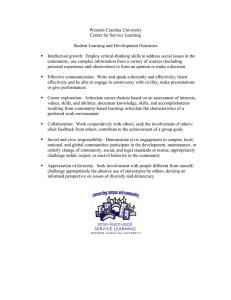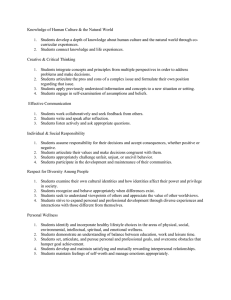Quality Matters Rubric Standards 2008-2010 edition with Assigned Point Values Standard Points
advertisement

Accessibility Learner Support Course Technology Learner Engagement Resources and Materials Assessment and Measurement Learning Objectives Course Overview and Introduction Quality Matters Rubric Standards 2008-2010 edition with Assigned Point Values Standard Points 1.1 Instructions make clear how to get started and where to find various course components. 1.2 A statement introduces the student to the purpose of the course and to its components; in the case of a hybrid course, the statement clarifies the relationship between the face-to-face and online components. 1.3 Etiquette expectations (sometimes called “netiquette” for online discussions, email, and other forms of communication are stated clearly. 1.4 The self-introduction by the instructor is appropriate and available online. 1.5 Students are asked to introduce themselves to the class. 1.6 Minimum student preparation, and, if applicable, prerequisite knowledge in the discipline are clearly stated. 1.7 Minimum technical skills expected of the student are clearly stated. 3 3 2.1 The course learning objectives describe outcomes that are measurable. 2.2 The module/unit learning objectives describe outcomes that are measurable and consistent with the course-level objectives. 2.3 All learning objectives are stated clearly and written from the students’ perspective. 2.4 Instructions to students on how to meet the learning objectives are adequate and stated clearly. 2.5 The learning objectives are appropriately designed for the level of the course. 3.1 The types of assessments selected measure the stated learning objectives and are consistent with course activities and resources. 3.2 The course grading policy is stated clearly. 3.3 Specific and descriptive criteria are provided for the evaluation of students’ work and participation. 3.4 The assessment instruments selected are sequenced, varied, and appropriate to the content being assessed. 3.5 “Self-check” or practice assignments are provided, with timely feedback to students. 3 3 4.1 4.2 4.3 4.4. 3 3 2 1 The instructional materials contribute to the achievement of the stated course and module/unit learning objectives. The relationship between the instructional materials and the learning activities is clearly explained to the student. The instructional materials have sufficient breadth, depth, and currency for the student to learn the subject. All resources and materials used in the course are appropriately cited. 1 1 1 1 1 3 3 2 3 3 3 2 2 5.1 The learning activities promote the achievement of the stated learning objectives. 5.2 Learning activities foster instructor-student, content-student, and if appropriate to the course, student-student interaction. 5.3 Clear standards are set for instructor responsiveness and availability (turn-around time for email, grade posting, etc.) 5.4 The requirements for student interaction are clearly articulated. 3 3 6.1 The tools and media support the learning objectives, and are appropriately chosen to deliver the content of the course. 6.2 The tools and media support student engagement and guide the student to become an active learner. 6.3 Navigation throughout the online components of the course is logical, consistent, and efficient. 6.4 Students have ready access to the technologies required in the course. 6.5 The course components are compatible with current standards for delivery modes. 6.6 Instructions on how to access resources at a distance are sufficient and easy to understand. 6.7 The course design takes full advantage of available tools and media. 7.1 The course instructions articulate or link to clear description of the technical support offered. 7.2 Course instructions articulate or link to an explanation of how the institution’s academic support system can assist the student in effectively using the resources provided. 7.3 Course instructions articulate or link to an explanation of how the institution’s student support services can help students reach their educational goals. 7.4 Course instructions answer basic questions related to research, writing, technology, etc., or link to tutorials or other resources that provide the information. 8.1 The course incorporates ADA standards and reflect conformance with institutional policy regarding accessibility in online and hybrid courses. 8.2 Course pages and course materials provide equivalent alternatives to auditory and visual content. 8.3 Course pages have links that are self-describing and meaningful. 8.4 The course ensures screen readability. 3 To meet Quality Matters review expectations a course must: Answer ‘Yes’ to all 3-point Essential Standards AND Earn 72 or more points. MarylandOnline, Inc. ©2008. All rights reserved. 2 2 3 3 2 1 1 1 2 2 1 1 3 2 2 1





